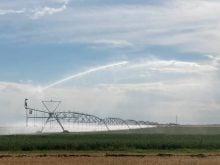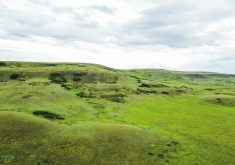Red-headed woodpeckers are a sharp-looking bird.
With ruby-red feathers on their head, a white chest and black on their wings and back, they stand out from other birds in the forest.
But they are struggling.
Estimates suggest there are only 6,000 red-headed woodpeckers left in North America. That’s why a conservation group, Manitoba Important Bird Areas, is trying to preserve their habitat.
“For red-headed woodpeckers … across Canada from 1970 to 2016, (there’s been) a 58 percent decline,” said Marissa Bedard, program co-ordinator for Manitoba Important Bird Areas.
Read Also

Saskatchewan puts crown land auction on hold
Auctions of Saskatchewan crown lease land are once again on hold.
“They’re listed as species at risk because of these numbers…. They’re declining, and the (biggest) factor is habitat loss.”
The organization has designated 36 locations in Manitoba that are critical for wild birds. Saskatchewan and Alberta have similar programs for important bird areas. There are 53 designated sites in Saskatchewan and 47 in Alberta.
Bedard had a booth at the Manitoba Beef Producers annual meeting in Winnipeg in early February because she’s hoping livestock producers can help increase the population of red-headed woodpeckers and another endangered bird — the eastern whip-poor-will.
Forested land used for cattle grazing is an ideal habitat for the two species.
The red-headed woodpecker likes a forest with dead, standing trees. They use the dead trees to excavate a nest.
“These birds can be found in the provinces of Saskatchewan, Manitoba, Ontario, and Québec,” says birdscanada.org.
“Forest breeding habitat must have a high density of dead limbs or trees, an open canopy and little understory vegetation.”
The ideal habitat for red-headed woodpeckers in Manitoba are close to Turtle Mountain, Oak Lake, the Shoal Lakes and the western shore of Lake Manitoba, around Alonsa.
Manitoba Important Bird Areas has a new initiative, called Conservation Champions, asking cattle ranchers in those regions and other areas to preserve land with dead trees and minimal undergrowth.
“Not any shrubs or vegetation on the ground. They like a cleared-out area,” Bedard said.
“Which is why we tend to find them in areas with cattle (or sheep).”
The Conservation Champions program isn’t asking a lot of cattle ranchers and other landowners. Basically, don’t do anything that changes the existing habitat for red-headed woodpeckers and eastern whip-poor-wills.
“We’re looking for landowners to sign non-legally binding agreements to simply maintain what is there…. (A) keep-doing-what-you’re-doing situation,” Bedard said.
“If there are standing dead trees … just asking that those stay up.”
Landowners who join the program will receive a “Conservation Champions” gate sign to post at their farmyard and a survey of birds on their property, if requested.
“We can go out there and come up with a list of all the species that we heard or saw,” Bedard said.
Manitoba Important Bird Areas plans to hold information sessions across the province later this month and in March to make landowners aware of the program.
Starting at 6 p.m., the events will be held:
- Feb. 22, Inwood Community Centre
- Feb. 28, Langruth Rec Centre
- March 1, St. Laurent Community Centre
- March 22, Pipestone Community Hall (time TBD)
For more information bout Manitoba Important Bird Areas and the Conservation Champions program, visit importantbirdareasmb.ca/.
















